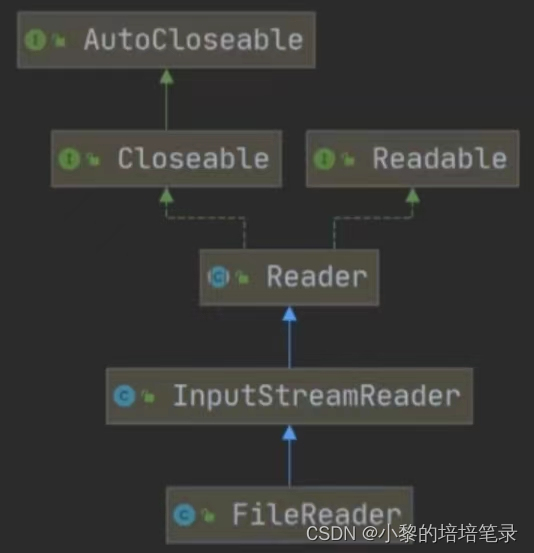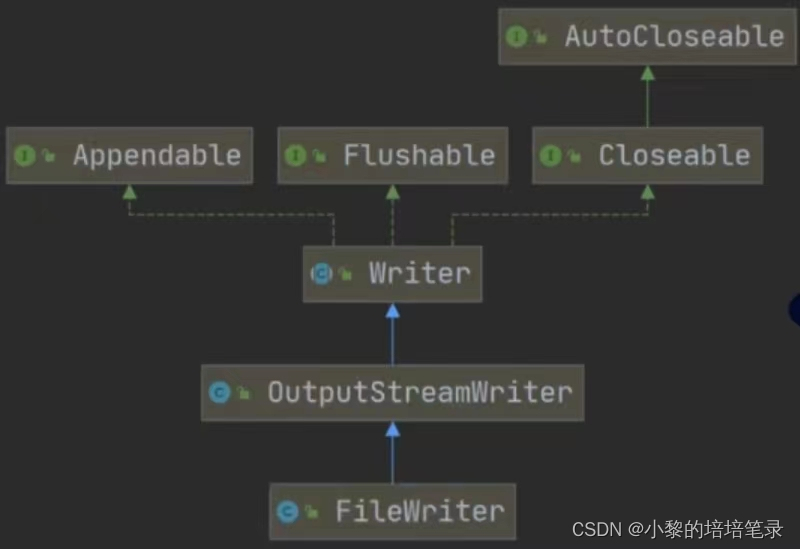目录
一、FileInputStream 文件输入流
1、单个字节读取文件
public void readFile01(){ //文件路径 String filePath = "d:\\hello.txt"; //用于接收单个字节 int readData = 0; //初始化FileInputStream,首先置为空 FileInputStream fileInputStream = null; try { //创建FileInputStream 对象,用于读取 文件 fileInputStream = new FileInputStream(filePath); //从该输入流读取一个字节的数据,如果没有输入可用,此方法将被阻止 //如果返回-1,表示读取完毕 while((readData = fileInputStream.read()) != -1){ System.out.print((char) readData);//转成char显示 } } catch (IOException e) { e.printStackTrace(); }finally { //关闭文件流,释放资源 try { fileInputStream.close(); } catch (IOException e) { e.printStackTrace(); } } }2、使用 read(byte[] b) 进行优化
public void readFile02(){ //文件路径 String filePath = "d:\\hello.txt"; //首先定义一个字节数组 byte[] buf = new byte[8]; //一次性读取8个字节 //读取长度 int readLength = 0; //初始化FileInputStream ,置为空 FileInputStream fileInputStream = null; try { //创建FileInputStream 对象,用于读取 文件 fileInputStream = new FileInputStream(filePath); //从该输入流读取最多b.length字节的数据到字节数组。如果没有输入可用,此方法将被阻止 //如果返回-1,表示读取完毕 //如果读取正常,返回实际读取的字节数 while((readLength = fileInputStream.read(buf)) != -1){ System.out.print(new String(buf , 0 , readLength));//显示 } } catch (IOException e) { e.printStackTrace(); }finally { //关闭文件流,释放资源 try { fileInputStream.close(); } catch (IOException e) { e.printStackTrace(); } } }
二、FileOutputStream 文件输出流
1、创建方式: (1)new FileOutputStream(filePath) 的创建方式,当写入内容是会覆盖原来的内容 (2)new FileOutputStream(filePath,true) 的创建方式,当写入内容是,追加到到文件的尾部,不会覆盖 2、代码示例:public void writeFile(){ //创建FileOutputStream 对象 String filePath = "d:\\a.txt"; FileOutputStream fileOutputStream = null; try { //得到FileOutputStream 对象 fileOutputStream = new FileOutputStream(filePath); //写入一个字节 fileOutputStream.write('H');//char 和 int 之间可以自动转换 //写入字符串 String str = "hello,world"; //str.getBytes() 可以把 字符串 -> 字节数组 fileOutputStream.write(str.getBytes()); //write(byte[] b,int off,int len) ,将len 字节从位于偏移量off指定字节数组写入 fileOutputStream.write(str.getBytes(),0,str.length()); } catch (IOException e) { e.printStackTrace(); } finally { try { fileOutputStream.close(); } catch (IOException e) { e.printStackTrace(); } } }3、文件拷贝代码示例
public class FileCopy { public static void main(String[] args) { //将d:\\by.png 拷贝到 d:\\bycopy.png //源文件路径 String srcFilePath = "d:\\by.png"; //新文件路径 String destFilePath = "d:\\bycopy.png"; //初始化FileInputStream 输入流 FileInputStream fileInputStream = null; //初始化FileOutputStream 输出流 FileOutputStream fileOutputStream = null; try { //获取输入流对象 fileInputStream = new FileInputStream(srcFilePath); //获取输出流对象 fileOutputStream = new FileOutputStream(destFilePath); //定义一个字节数组,提高效率 byte[] buf = new byte[1024]; //获取数组长度 int readLen = 0; while ((readLen = fileInputStream.read(buf)) != -1){ //读取到后,就写入到文件 通过 fileOutputStream ,即边读边写 fileOutputStream.write(buf,0,readLen); //一定要使用这个方法 } System.out.println("拷贝成功"); } catch (IOException e) { e.printStackTrace(); }finally { //输入流和输出流都要关闭 try { if (fileInputStream != null){ fileInputStream.close(); } if (fileOutputStream != null){ fileOutputStream.close(); } } catch (IOException e) { e.printStackTrace(); } } }
三、FileReader 字符流
1、相关方法:

方法 功能 new FilleReader(File/String) 创建对象 read( ) 每次读取单个字节,返回该字符,如果到文件末尾返回-1 read( char[] ) 批量读取多个字符到数组,返回读取到的字符数,如果到文件末尾,则返回-1 new String( char[] ) 将 char[ ] 转换成String new String(char[] , off, len) 将 char[] 的指定部分转换成String 2、代码示例:单个字符进行读取
public void readFile01(){ //文件路径 String filePath = "d:\\story.txt"; //初始化对象 FileReader fileReader = null; //接收单个字节 int data = 0; try { //1、创建一个FileReader 对象 fileReader = new FileReader(filePath); //循环读取,使用read ,单个字符读取 while ((data = fileReader.read()) != -1){ System.out.print((char) data); } } catch (IOException e) { e.printStackTrace(); }finally { try { fileReader.close(); } catch (IOException e) { e.printStackTrace(); } } }3、代码示例:字符数组进行读取
public void readFile02(){ //文件路径 String filePath = "d:\\story.txt"; //初始化对象 FileReader fileReader = null; //字符长度 int readLen = 0; //创建数组 char[] buf = new char[8]; try { //1、创建一个FileReader 对象 fileReader = new FileReader(filePath); //循环读取,使用read(buf) ,返回的是实际读取到的字符数 //如果返回-1,说明文件结束 while ((readLen = fileReader.read(buf)) != -1){ System.out.print(new String(buf,0,readLen)); } } catch (IOException e) { e.printStackTrace(); }finally { try { fileReader.close(); } catch (IOException e) { e.printStackTrace(); } } }
四、FileWriter 字符流
1、相关方法
方法 功能 new FileWriter(File/String) 覆盖模式,相当于流的指针在首端 new FileWriter(File/String , true) 追加模式,相当于流的指针在尾端 write(int a) 写入单个字符 write(char[] ) 写入指定数组 write(char[] , off , len) 写入指定数组的指定部分 write (string b) 写入整个字符串 write(string , off , len) 写入字符串的指定部分 2、代码示例
public class FileWriter_ { public static void main(String[] args) { //文件路径 String filePath = "d:\\note.txt"; //创建FileWriter 对象 FileWriter fileWriter = null; char[] chars = {'a','b','c'}; try { //获取对象 fileWriter = new FileWriter(filePath);//默认是覆盖写入 //write(int):写入单个字符 fileWriter.write('H'); //write(char[]): 写入指定数组 fileWriter.write(chars); //write(char[] ,off,len) : 写入指定数组的指定部分 fileWriter.write(chars , 0 , 2); fileWriter.write("努力学习".toCharArray(), 0 , 2); //write(String) : 写入整个字符串 fileWriter.write("努力学习"); //write(String,off,len) : 写入字符串的指定部分 fileWriter.write("继续加油", 0 , 2); } catch (IOException e) { e.printStackTrace(); } finally { try { //必须要关闭流,否则无法写入 //fileWriter.flush(); fileWriter.close(); } catch (IOException e) { e.printStackTrace(); } } }
























 1万+
1万+











 被折叠的 条评论
为什么被折叠?
被折叠的 条评论
为什么被折叠?










